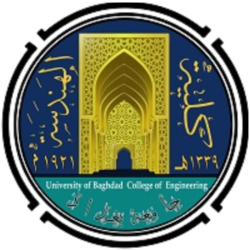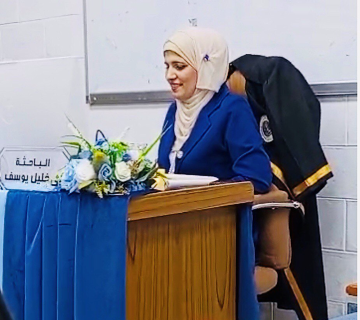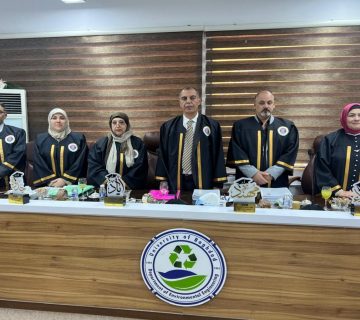Environmental Engineering Department at the College of Engineering, University of Baghdad, held PhD dissertation examination titled:
“Synthesis, Characterization and Application of CaMgAl-Layered Double Hydroxide/Red Mud Nanocomposite for Adsorption of Antibiotics from Aqueous Solution: Batch and Continuous Studies”
By the student Zahraa Ali Hammood and supervised Prof.Dr. Ahmed Abed Mohammed in Monday 26/5/2025, in the Environmental Engineering discussion hall. The examination committee consisted of Prof.Dr.Qusai Fadhil Abd AlHameed as Chairman, and the membership of Prof.Dr. Muhanned Jasim Mohammed Ridha, Prof.Dr. Khalid Khazaal Hummady, Assist.Prof.Dr. Hayder Mohammed Abd AlHameed and Assist.Prof.Dr. Hussein Jabbar Kadhim. After conducting the public discussion and listening to the student’s defense, the dissertation was accepted. It was summarized as follows:
This study focused on CaMgAl layered double hydroxide (LDH) based nanocomposites prepared by red mud (RM) co-precipitation method. The prepared red mud supported CaMgAl-LDH was characterized by transmission electron microscopy (TEM), powder X-ray diffraction (XRD), field emission scanning electron microscopy (SEM), energy dispersive X-ray spectroscopy (EDS), Brunauer-Emmett-Teller analysis (BET) and Fourier transform infrared spectroscopy (FTIR) and subsequently used for the sequestration of tetracycline (TEC), ciprofloxacin (CIP), and sulfamethoxazole (SMZ) from aqueous solution in batch mode experiments and continuous fixed bed columns. The experimental adsorption data fitted the Langmuir isotherm model well and the pseudo second order model described the adsorption kinetics of antibiotics on CaMgAl-LDH/RM sites. Instead, the adsorption mechanism was controlled by external mass transfer and intraparticle diffusion. To achieve a BET surface area of 58.2396 m2/g, a pH of 12, a Ca:Mg:Al molar ratio of 2:1, and a dosage of 3 g RM/100 ml were required. The prepared adsorbent showed excellent affinity for adsorbing antibiotics with maximum adsorption capacity of 108.753 mg/g for TEC and 138.1605 mg/g for CIP in single mode. The maximum TEC removal (96.91%) was obtained under the optimal conditions: pH 6, stirring speed 150 rpm, dosage 0.4 g/100 ml, pollutant concentration 70 mg/l, and contact time 90 min. The maximum CIP removal efficiency (89.45%) was achieved under the optimal conditions: pH 7, stirring speed 150 rpm, adsorbent dosage 0.5 g/100 ml, pollutant concentration 70 ppm, and contact time 90 min. Thermodynamic parameters (ΔG°, ΔS°, ΔH°) indicated that the adsorption of antibiotics by red mud-CaMgAl was spontaneous and exothermic. Moreover, the synthesized adsorbent could be recovered after six consecutive regeneration cycles with minimal decrease in adsorption capacity of 27% for TEC and 31% for CIP. To evaluate the efficiency of sulfamethoxazole (SMZ) removal, response surface methodology (RSM) with a central composite design (CCD) was used to evaluate the effects of experimental conditions, including pH, adsorbent dosage, initial SMZ concentration, and contact time. Maximum sequestration efficiency was seen 87.33% under the most favorable conditions. Analysis of variance (ANOVA) based on the CCD-RSM showed a good fit between quadratic model predictions with the experimental results with an R2 value of 0.9703. The optimum conditions based on the removal efficiency of SMZ (pH=7.6913, Dosage=0.55509 g/100 ml, Concentration=67.8324 mg/l, Time=102.542 min.) at which the maximum efficiency result is 85.4388%. In this study, a ternary antibiotic system consisting of TEC, CIP and SMZ was subjected for treatment using synthesized composite (CaMgAl-LDH/RM) in batch system. The results illustrated the optimum conditions are based on the removal efficiency of antibiotics (pH=6.936, Dosage=0.493 g/100 ml, Concentration of TEC=63.854 mg/l, Concentration of CIP=85.245 mg/l, Concentration of SMZ=62.699 mg/l, Time=98.964 min.) at which the maximum efficiency result is 80.638% for TEC, 64.077% for CIP, and 62.187% for SMZ. On the other hand, the potential of CaMgAl-LDH/RM was investigated for antibiotics removal from synthetic wastewater in a fixed-bed adsorption column. The effect of flow rate (30, 50, and 75 ml/min), the bed height (80, 100, and 150 mm) and initial antibiotic concentration (25, 50, and 100 mg/l) explained the behavior of the breakthrough curves. The breakthrough time decreased with increasing flow rate and antibiotic concentration at the inlet, but increased with increasing adsorbent bed height. The breakthrough curve analysis showed that antibiotic adsorption on CaMgAl-LDH/RM was most effective when the flow rate was 30 ml/min, the inlet antibiotic concentration was 25 mg/l, and the bed height was 150 mm. Four common fixed-bed models fit the breakthrough curves: Bohart-Adams, Clark, Yan, and Yoon-Nelson models; the Bohart-Adams and Yoon-Nelson models best fit the experimental data under all conditions (R2 ≥ 0.98). In conclusion, this study suggests that the CaMgAl-LDH/RM composite a promising adsorbent for the removal of antibiotics from wastewater.
Recommendations as follows:
- The degrading mechanism of hazardous chemicals utilizing LDH-based nanoparticles in wastewater systems requires more attention.
- Future research should be conducted to determine how magnetic CaMgAl-LDH/RM can be obtained as iron oxides help to improve pore quality.
- More studies should be conducted to examine the removal of pollutants like heavy metals, pesticides, hazardous organic dyes, persistent organic contaminants, and explosive compounds by CaMgAl-LDH/RM.
- Use LDH material to eliminate contaminants in other systems, use as nanofiller in ultrafiltration membranes to eliminate various contaminants from wastewater.
- It is proposed to adjust the Ca/Mg/Al ratio in CaMgAl-LDH/MSC to maintain calcium levels within the 150 mg/l limit while keeping magnesium below 100 mg/l, ensuring compliance with standards without compromising adsorption efficiency or causing secondary contamination.








